An SIC-Fed Low-Profile Wideband Metamaterial-Based Antenna Array for 5G Wireless Cellular Networks
Abstract
:1. Introduction
2. Metamaterial-Based Low-Profile Wideband Antenna Element
2.1. Overview
2.2. Operating Principle
2.3. Experimental Results
3. Array Antenna
3.1. Array Antenna Design
3.2. Parametric Studies
3.3. Comparisons of Two Types of Antenna Arrays
3.4. Array Antenna Experimental Results
4. Conclusions
Author Contributions
Funding
Institutional Review Board Statement
Informed Consent Statement
Acknowledgments
Conflicts of Interest
References
- Rai, Y.; Jaiswal, K.; Raina, R.; Yadav, S.; Srivastav, R. Analysis of Evolved Shape Dual-Band 2 × 1 Microstrip Patch Array Antenna on Different Substrate and Size. In Proceedings of the 2020 Third International Conference on Smart Systems and Inventive Technology (ICSSIT), Tirunelveli, India, 20–22 August 2020; pp. 260–265. [Google Scholar] [CrossRef]
- Gauthier, G.; Courtay, A.; Rebeiz, G. Microstrip antennas on synthesized low dielectric-constant substrates. IEEE Trans. Antennas Propag. 1997, 45, 1310–1314. [Google Scholar] [CrossRef]
- Chang, E.; Long, S.; Richards, W. An experimental investigation of electrically thick rectangular microstrip antennas. IEEE Trans. Antennas Propag. 1986, 34, 767–772. [Google Scholar] [CrossRef]
- Chen, Z.N.; Chia, M.Y.W. Broadband Planar Antennas: Design and Applications; Wiley: Hoboken, NJ, USA, 2006. [Google Scholar]
- Lee, K.; Luk, K.; Tong, K.; Shum, S.; Huynh, T.; Lee, R. Experimental and simulation studies of the coaxially fed U-slot rectangular patch antenna. IEE Proc.-Microw. Antennas Propag. 1997, 144, 354–358. [Google Scholar] [CrossRef]
- Tong, K.-F.; Luk, K.M.; Lee, K.-F.; Lee, R.Q. A broad-band U-slot rectangular patch antenna on a microwave substrate. IEEE Trans. Antennas Propag. 2000, 48, 954–960. [Google Scholar] [CrossRef]
- Weigand, S.; Huff, G.; Pan, K.; Bernhard, J. Analysis and design of broad-band single-layer rectangular u-slot microstrip patch antennas. IEEE Trans. Antennas Propag. 2003, 51, 457–468. [Google Scholar] [CrossRef]
- Yang, S.-L.S.; Luk, K.-M. Design of a wide-band L-probe patch antenna for pattern reconfiguration or diversity applications. IEEE Trans. Antennas Propag. 2006, 54, 433–438. [Google Scholar] [CrossRef]
- Chen, Z.; Chia, M. Broadband suspended plate antenna with probe-fed strip. IEE Proc.-Microw. Antennas Propag. 2001, 148, 37–40. [Google Scholar] [CrossRef]
- Matin, M.; Sharif, B.; Tsimenidis, C.C. Probe Fed Stacked Patch Antenna for Wideband Applications. IEEE Trans. Antennas Propag. 2007, 55, 2385–2388. [Google Scholar] [CrossRef]
- Engheta, N.; Ziolkowski, R.W. Electromagnetic Metamaterials: Physics and Engineering Explorations; Wiley: Hoboken, NJ, USA, 2006. [Google Scholar]
- Paulotto, S.; Baccarelli, P.; Frezza, F.; Jackson, D. Full-Wave Modal Dispersion Analysis and Broadside Optimization for a Class of Microstrip CRLH Leaky-Wave Antennas. IEEE Trans. Microw. Theory Tech. 2008, 56, 2826–2837. [Google Scholar] [CrossRef]
- Zhu, J.; Eleftheriades, G. A Compact Transmission-Line Metamaterial Antenna with Extended Bandwidth. IEEE Antennas Wirel. Propag. Lett. 2009, 8, 295–298. [Google Scholar] [CrossRef]
- Liu, W.; Chen, Z.N.; Qing, X. Metamaterial-Based Low-Profile Broadband Mushroom Antenna. IEEE Trans. Antennas Propag. 2014, 62, 1165–1172. [Google Scholar] [CrossRef]
- Mao, C.X.; Khalily, M.; Xiao, P.; Brown, T.W.; Gao, S. Planar Sub-Millimeter-Wave Array Antenna With Enhanced Gain and Reduced Sidelobes for 5G Broadcast Applications. IEEE Trans. Antennas Propag. 2018, 67, 160–168. [Google Scholar] [CrossRef] [Green Version]
- Zhao, X.; Song, K.; Zhu, Y.; Fan, Y. Wideband Four-Way Filtering Power Divider With Isolation Performance Using Three Parallel-Coupled Lines. IEEE Microw. Wirel. Compon. Lett. 2017, 27, 800–802. [Google Scholar] [CrossRef]
- Zhu, H.; Abbosh, A.; Guo, L. Wideband Four-Way Filtering Power Divider With Sharp Selectivity and Wide Stopband Using Looped Coupled-Line Structures. IEEE Microw. Wirel. Compon. Lett. 2016, 26, 413–415. [Google Scholar] [CrossRef]
- Chen, X.-P.; Wu, K.; Drolet, D. Substrate Integrated Waveguide Filter with Improved Stopband Performance for Satellite Ground Terminal. IEEE Trans. Microw. Theory Tech. 2009, 57, 674–683. [Google Scholar] [CrossRef]
- Wang, Z.; Zhang, G.-X.; Yin, Y.; Wu, J. Design of a Dual-Band High-Gain Antenna Array for WLAN and WiMAX Base Station. IEEE Antennas Wirel. Propag. Lett. 2014, 13, 1721–1724. [Google Scholar] [CrossRef]
- Qing, X.; Chen, Z.N. Metamaterial-based wideband horizontally polarized omnidirectional 5-GHz WLAN antenna array. In Proceedings of the 8th European Conference on Antennas and Propagation (EuCAP 2014), Hague, The Netherlands, 6–11 April 2014; pp. 605–608. [Google Scholar] [CrossRef]
- Chang, L.; Zhang, Z.; Li, Y.; Feng, Z. All-Metal Antenna Array Based on Microstrip Line Structure. IEEE Trans. Antennas Propag. 2015, 64, 351–355. [Google Scholar] [CrossRef]
- Zong, H.; Liu, X.; Ma, X.; Lin, S.; Liu, L.; Liu, S.; Fan, S. Design and Analysis of a Coupling-Fed Printed Dipole Array Antenna With High Gain and Omnidirectivity. IEEE Access 2017, 5, 26501–26511. [Google Scholar] [CrossRef]
- Jiang, X.; Zhang, Z.; Li, Y.; Feng, Z. A Planar Wideband Dual-Polarized Array for Active Antenna System. IEEE Antennas Wirel. Propag. Lett. 2014, 13, 544–547. [Google Scholar] [CrossRef]
- Kubwimana, J.L.; Kirsch, N.J.; Ziegler, C.; Kontopidis, G.; Tuner, B. Dual-Polarized 5.75 GHz Optically Transparent Antenna Arrays. IEEE Antennas Wirel. Propag. Lett. 2019, 18, 1512–1516. [Google Scholar] [CrossRef]


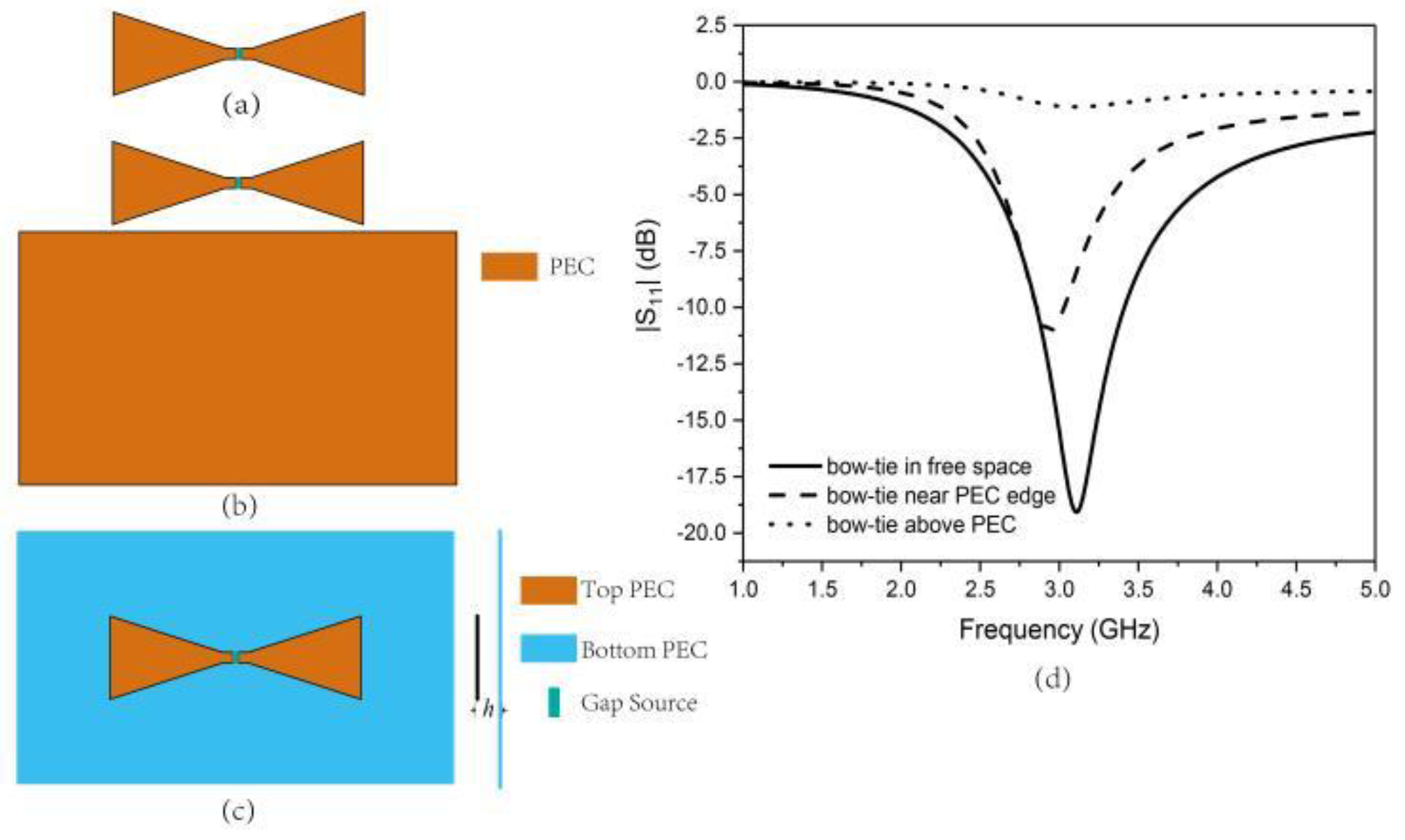
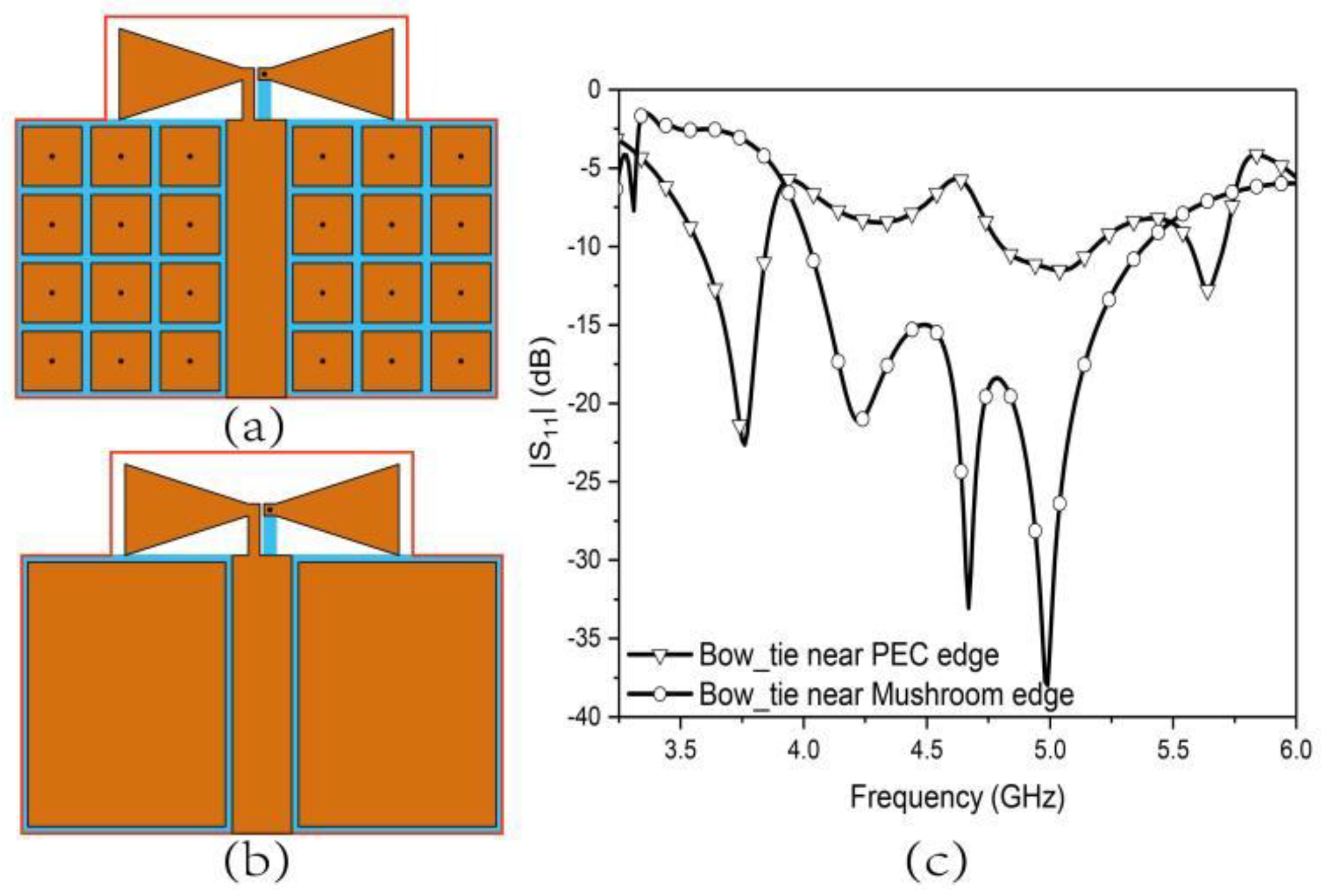
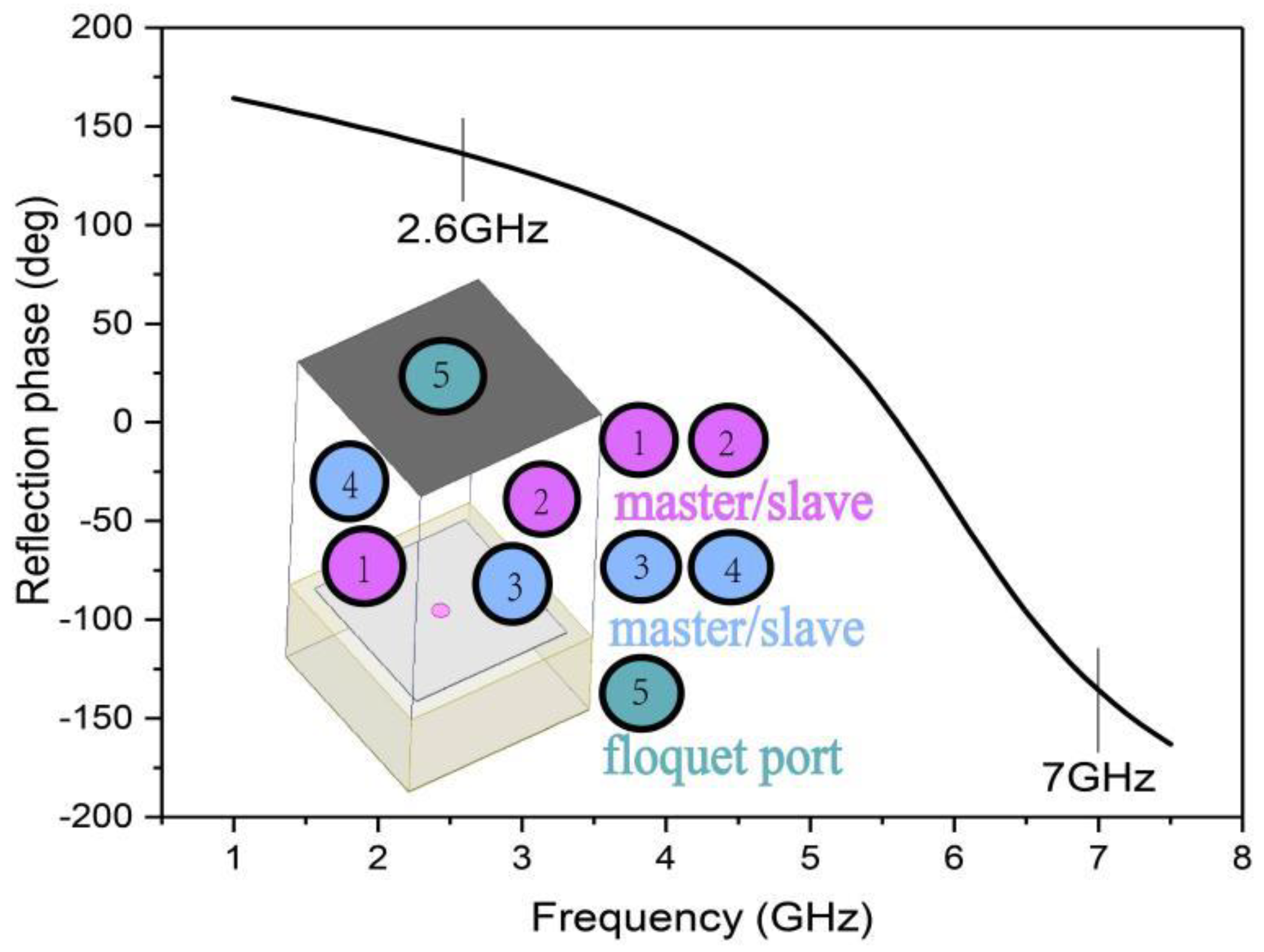



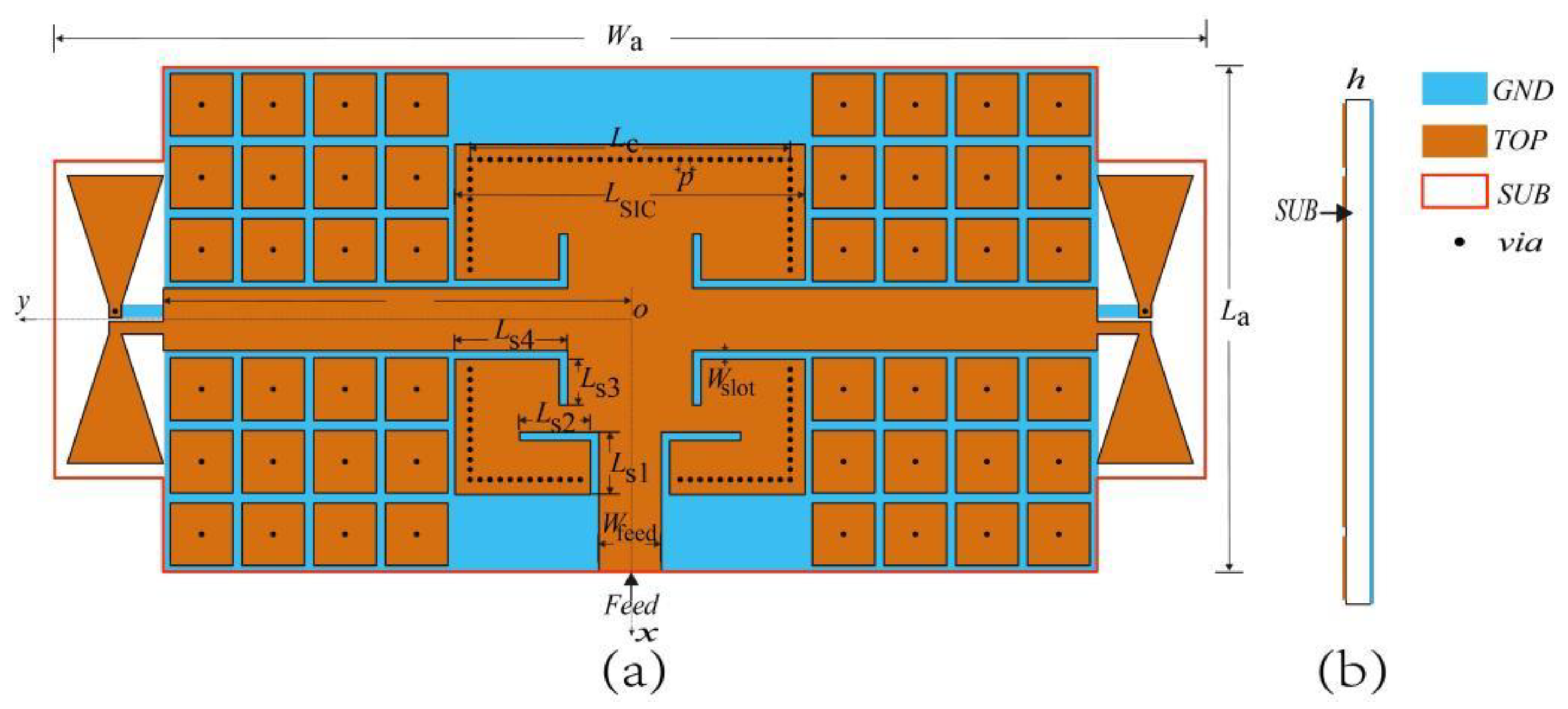
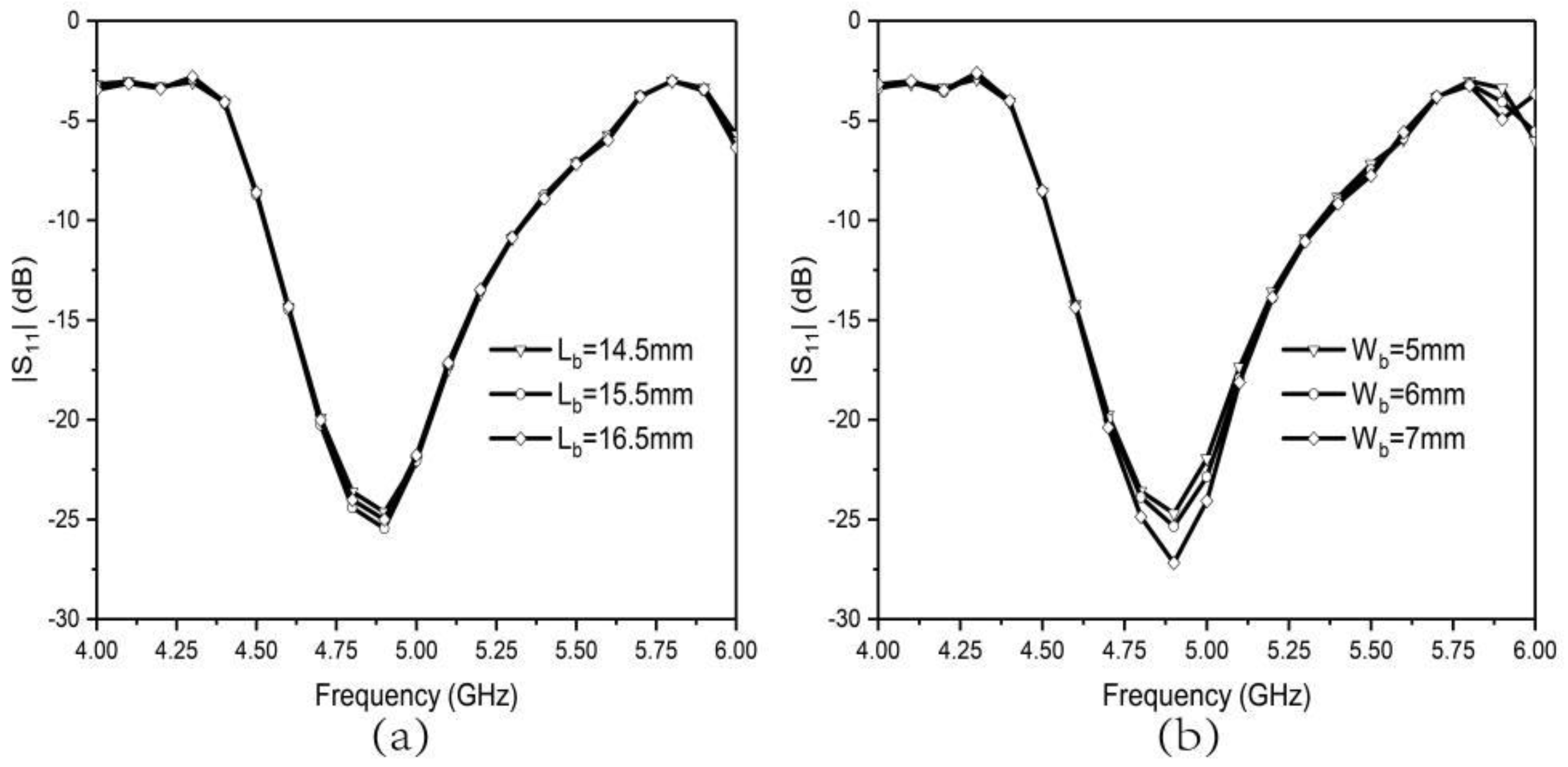
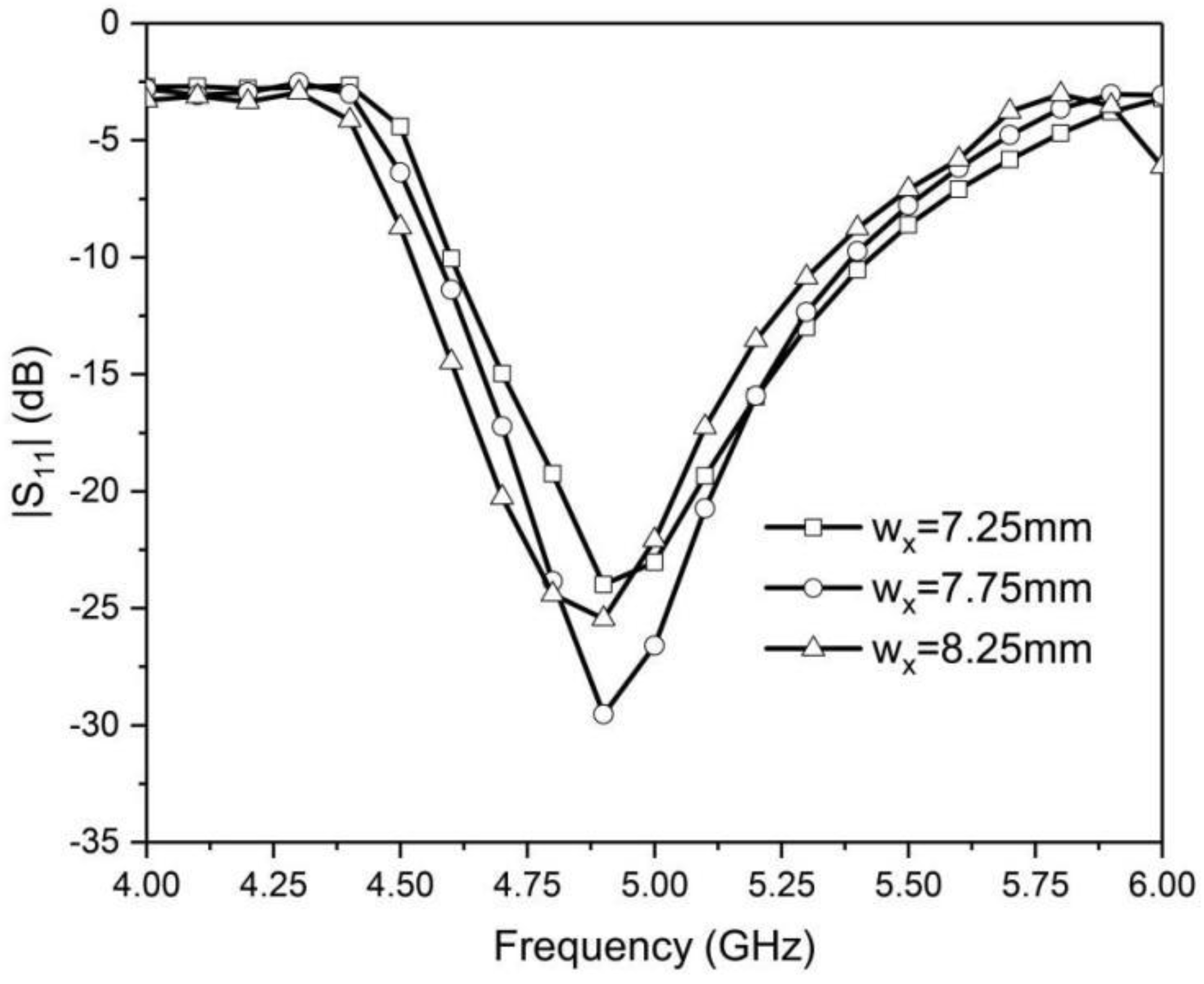

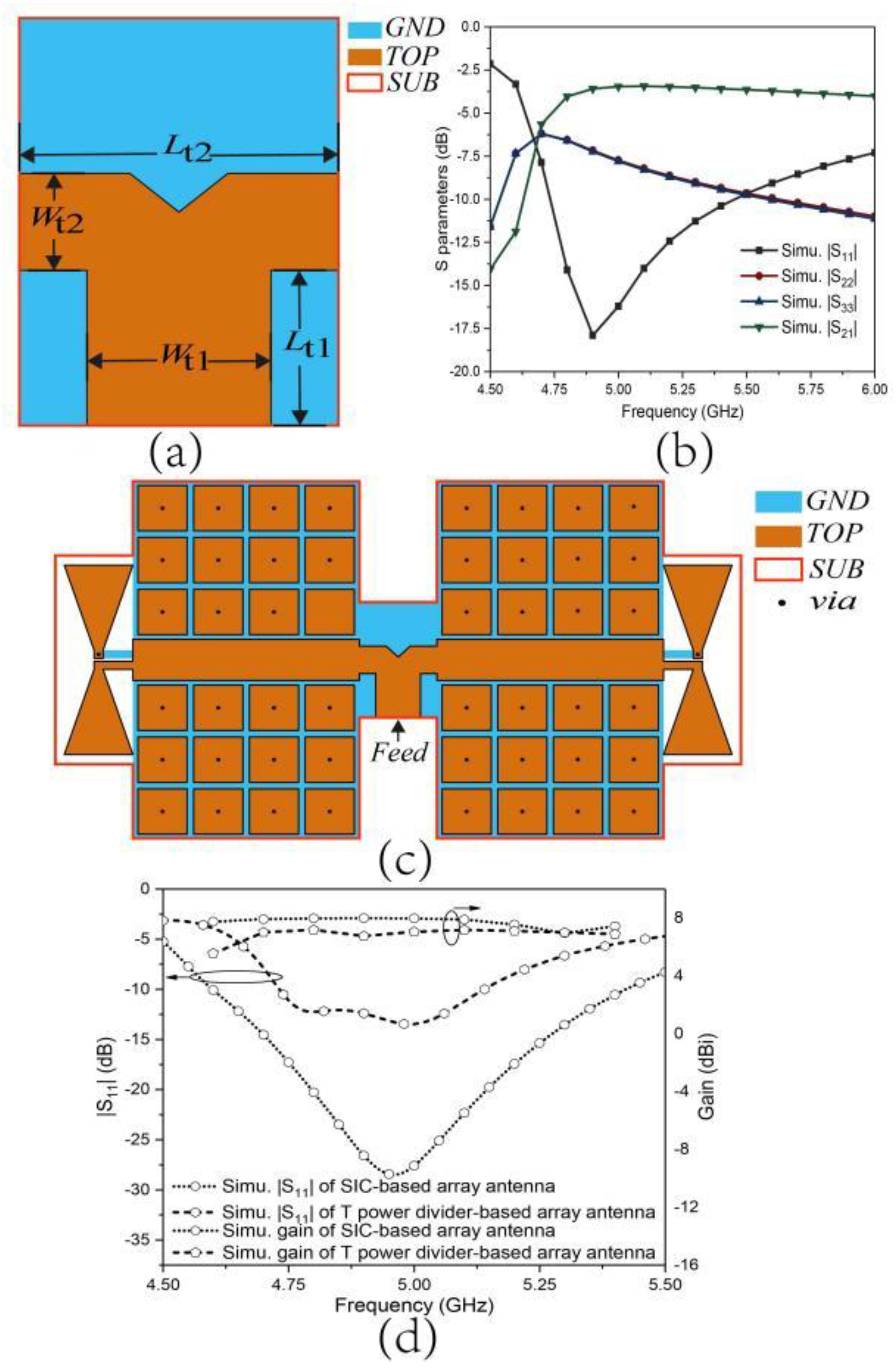
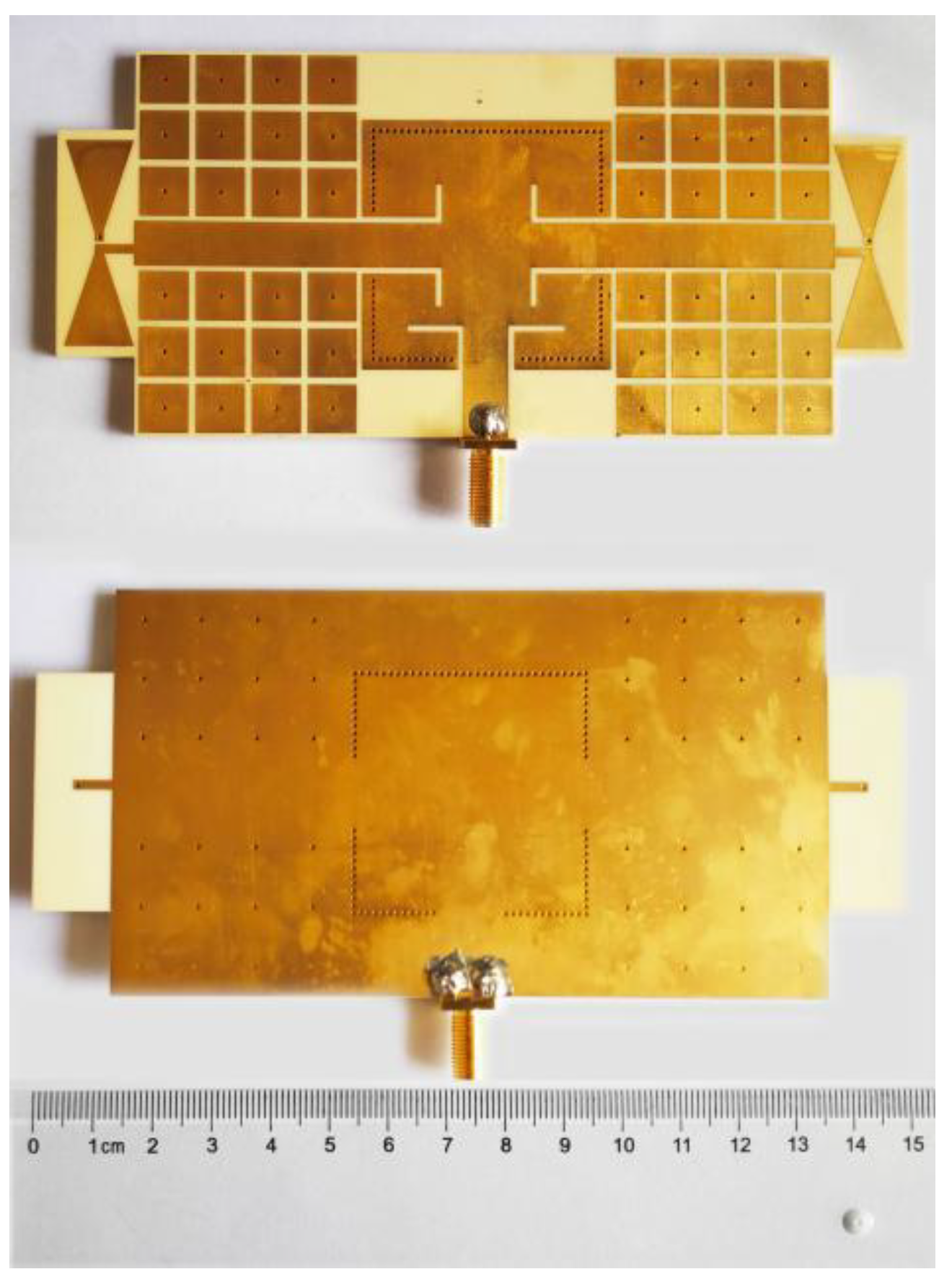
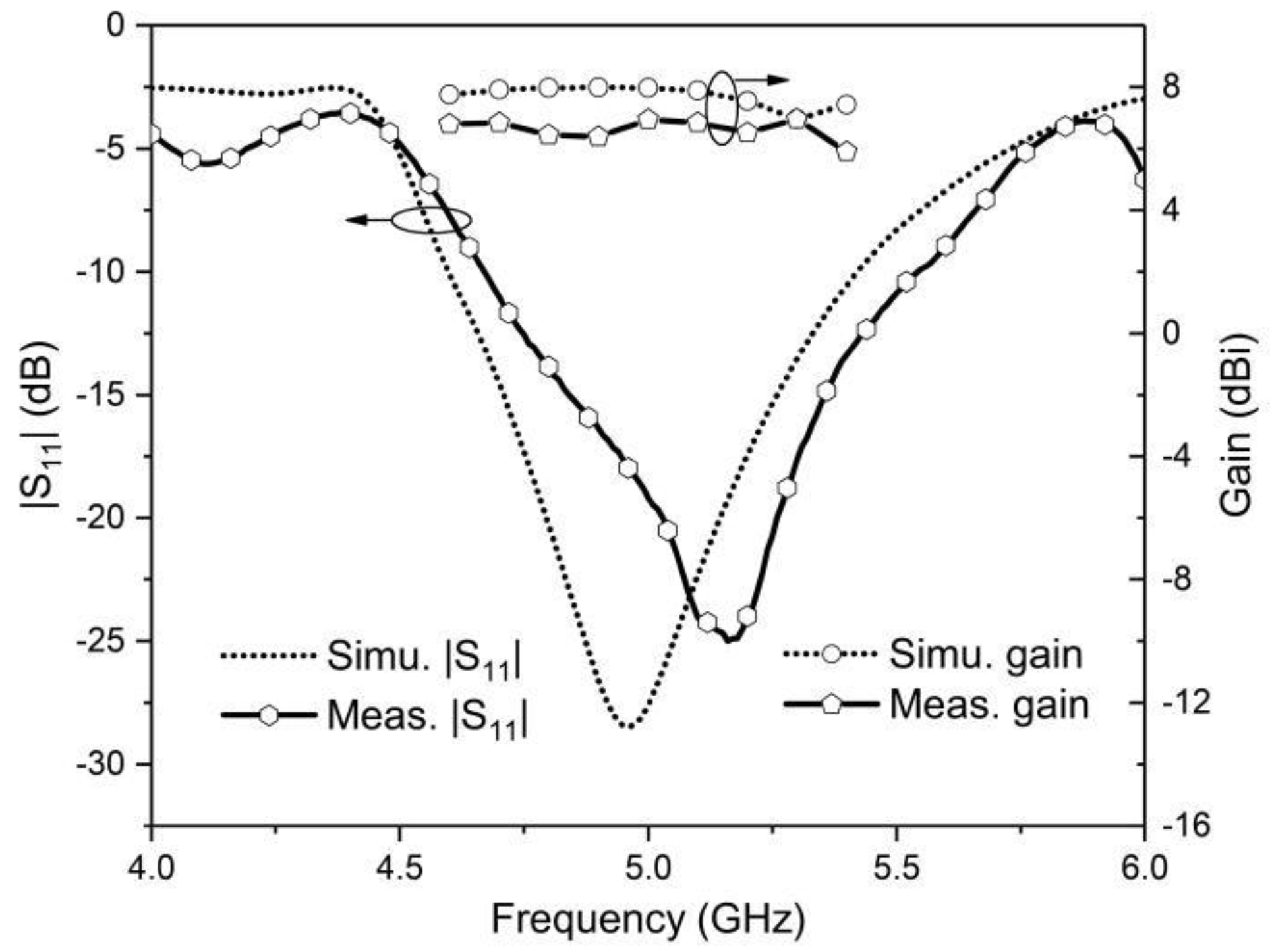
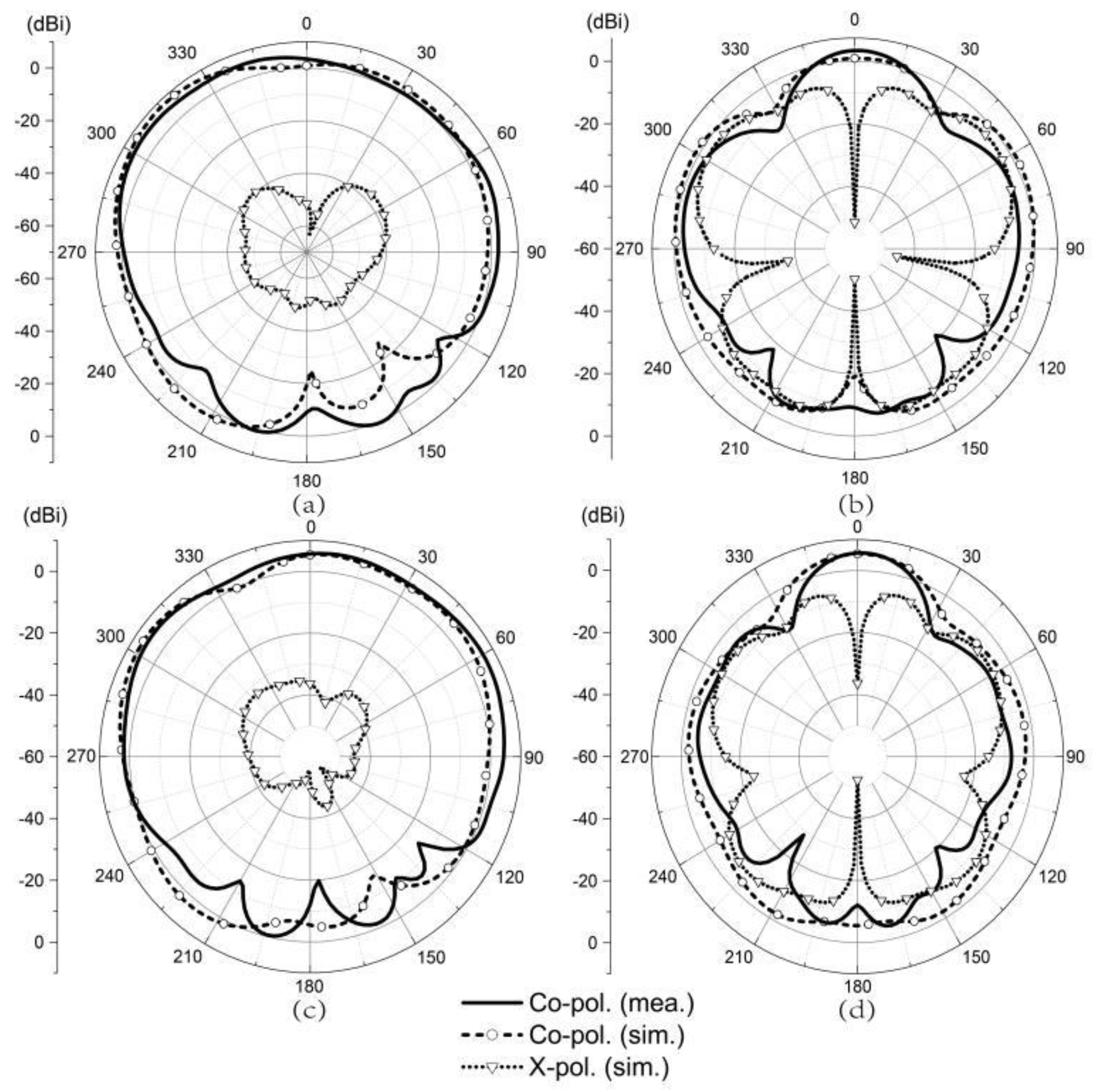

| Parameter | Value | Parameter | Value |
|---|---|---|---|
| 60.5 | 11.25 | ||
| L | 48 | 13 | |
| 7.5 | 1.1 | ||
| 7.5 | 1.2 | ||
| 1.5 | 0.85 | ||
| 8.75 | 0.75 | ||
| 5 | 15.5 | ||
| 7.5 | 38 |
| References | [19] | [20] | [21] | [22] | [23] | [24] | This Work |
|---|---|---|---|---|---|---|---|
| Overall size () | 1.66× 1.0× 0.23 | 3.8× 0.28× 0.62 | 4.44× 2.22× 0.08 | 1.81× 0.20× 0.02 | 2.5× 2.5× 0.29 | 1.13× 4.0× 0.03 | 2.4× 1.08× 0.05 |
| Center frequency (GHz) | 2.2 | 5 | 8.32 | 4.8 | 2.5 | 5.75 | 5 |
| Bandwidth (%) | 45 | 14.5 | 11.78 | 16.3 | 17 | 2.7–6 | 17 |
| Realized gain (dBi) | 9 | 5 | 9.1 | 5.8 | 6.0–7.6 | 6–7.2 | 6.6 |
Publisher’s Note: MDPI stays neutral with regard to jurisdictional claims in published maps and institutional affiliations. |
© 2022 by the authors. Licensee MDPI, Basel, Switzerland. This article is an open access article distributed under the terms and conditions of the Creative Commons Attribution (CC BY) license (https://creativecommons.org/licenses/by/4.0/).
Share and Cite
Wang, S.; Sun, L.; Ntawangaheza, J.d.D. An SIC-Fed Low-Profile Wideband Metamaterial-Based Antenna Array for 5G Wireless Cellular Networks. Designs 2022, 6, 43. https://doi.org/10.3390/designs6030043
Wang S, Sun L, Ntawangaheza JdD. An SIC-Fed Low-Profile Wideband Metamaterial-Based Antenna Array for 5G Wireless Cellular Networks. Designs. 2022; 6(3):43. https://doi.org/10.3390/designs6030043
Chicago/Turabian StyleWang, Shengjie, Liguo Sun, and Jean de Dieu Ntawangaheza. 2022. "An SIC-Fed Low-Profile Wideband Metamaterial-Based Antenna Array for 5G Wireless Cellular Networks" Designs 6, no. 3: 43. https://doi.org/10.3390/designs6030043






